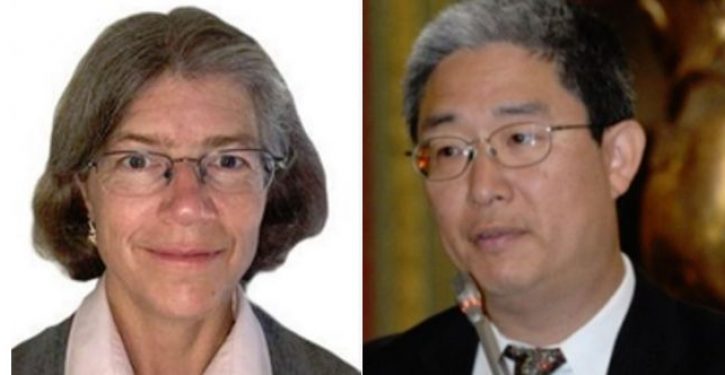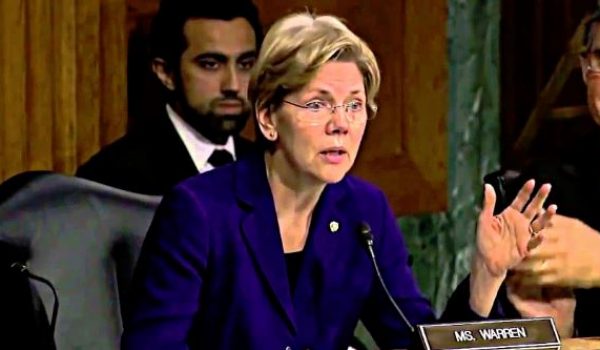
If you want to understand how Washington, D.C. can function as a swamp, where waters seem to sit undisturbed and specially adapted forms of life thrive in shadows, you can’t do better in the annals of Russiagate than to inspect what we have learned this past week about Nellie Ohr’s role in the events of 2016.
This isn’t an indictment of Ms. Ohr. That’s exactly why Washington is a swamp: because this is normal. There isn’t thought to be anything much wrong with it. Perhaps it got a little out of hand in the case of the Steele dossier and the FISA warrant against Carter Page, in which Ohr and her husband Bruce, a senior official at the Department of Justice, played integral parts. But although there were supposed to be some restraints on Bruce Ohr, given his wife’s employment, there isn’t any real firewall against what Nellie Ohr was doing.
She, after all, was functioning in the role of subject-matter expert (or “SME,” pronounced smee, in interagency-superhero parlance). She’s not a decision-maker or a money-monger. She’s not selling anti-air missiles or toilet paper to the federal government. Nellie Ohr is an academic who provides expert services on Russia and Russian topics. Based on what she has focused on in conference appearances since 2010, she seems to have had a background emphasis for some time in Russian crime, cybercrime, the culture of Russian activity on the Internet, and Russian state predation on the Web.
Will this presidential election be the most important in American history?
Her career as a contractor is unremarkable, which is a significant point. Since 2000, she has worked for MITRE Corporation, Plessas Experts Network, Miklos Systems, Fusion GPS, and VeriSign iDefense, which was later acquired by Accenture. Between her stints with MITRE and Plessas, she spent six years at Open Source Works, the CIA follow-on to the old Foreign Broadcast Information Service (FBIS). (Information from Yaacov Apelbaum.)

Some of the work she did was presumably under government contracts obtained by her employers. We can’t tell if all of it was – other than her stint with Fusion GPS, of course, in which she was not working for the government – but that’s possible, although unlikely.
(To take one example, during her time with Plessas Experts Network, where she was an analyst from October 2013 to January 2015, Plessas had only one recorded contract with a federal agency. It appears to have been a single-project contract that ran for only a month, in August and September of 2014. The contract was with the DOJ, and Ohr may well have been the analyst who did the work. But there aren’t other recorded U.S. government contracts for Plessas during the rest of her tenure there.)

Nellie Ohr has probably done some of her contract work for private companies and/or think-tanks. Some of those entities may subcontract government-contracted work out to her employer(s), in which case Ohr, fulfilling such contracts, might go in and out of federal buildings with a government badge in the course of her employment, even though her employer’s contract is actually with the lead contractor and not the government agency.
But there have probably been times as well when she didn’t do that. So although Fusion GPS is the only employer on her c.v. that doesn’t contract with the federal government, she is very likely well accustomed to switch-hitting as a routine feature of her work.
Doing Russia-related research for Fusion no doubt had its exotic moments. But in the end, it was just doing research and creating content about things Russian. Anybody in Washington or Northern Virginia could need that, when you think about it. Really, who doesn’t?
We have learned, moreover, that Ohr worked for Fusion as an independent contractor. That means she wasn’t under an employer’s contract with Fusion GPS. She had presumably incorporated in some way (and in some state; I haven’t found evidence of incorporation in Virginia), and made the contract with Fusion herself.
That seems to be the only specifically verified (or at least claimed) instance of independent contracting since 2000. But a key implication of the arrangement is that, as an independent contractor, she could also be working for others, without that fact necessarily being known to an employer.
Nellie Ohr’s dual roles in 2016
All of this sets the stage for what we found out this past week. Aside from evidence that Bruce Ohr’s testimony in Congress directly contradicts key points from the testimony of Glenn Simpson and Rod Rosenstein, the deputy attorney general, what we found out is that Nellie Ohr was funneling information as a government-experienced SME directly to Justice Department officials, at the same time she was creating content about that same information for Fusion GPS.
The newly revealed information is from two sources. One is the Bruce Ohr testimony posted by Rep. Doug Collins (R-GA), which was Ohr’s testimony to the House Judiciary Committee in August 2018. The other is a string of correspondence by the Ohrs, mostly emails, obtained by Judicial Watch via lawsuit from the DOJ.
It’s the latter that provides the really eye-opening information. The great bulk of the 339 (PDF) pages comprises emails originated or forwarded by Nellie Ohr – not just to Bruce Ohr, but to three officials of the DOJ’s Organized Crime Drug Enforcement Task Force (OCDETF): attorneys Lisa Holtyn, Joe Wheatley, and Ivana Nizich.
OCDETF was run by Bruce Ohr before he was promoted to deputy associate attorney general. It was his old shop. Lisa Holtyn is clearly a long-time associate, knowing both Bruce and Nellie Ohr. And although most readers probably think of “Latin American cartels” when they hear “Drug Enforcement Task Force,” the OCDETF does a lot of work with Russian cartels and the other deeply intertwined facets of Russian syndicate crime, including banking, money-laundering, and the threads of all these things that run through Ukraine. It was on matters Russian that Nellie Ohr was forwarding information and commentary to Holtyn and the other attorneys.
The timeframe for this ran from October 2015 to September 2016. Bruce Ohr’s testimony has already indicated that Nellie Ohr started her contract work for Fusion GPS at the end of 2015, which was probably no earlier than December 2015, since she was working for Miklos Systems up through that month.
The Nellie Ohr emails in Judicial Watch’s PDF document start on page 55. The Nellie Ohr section commences with an arresting exchange on 23 March 2016, in which Lisa Holtyn suggests to Bruce Ohr that Nellie be used as an expert source for Joe Wheatley and Ivana Nizich, who are assigned to the same project on the OCDETF. The nature/designation of the project is redacted.
From October 2015 to April 2016, Nellie sends informational emails full of Russian-topic content to Bruce Ohr, and frequently to Lisa Holtyn as well. (The emails are in reverse chronological order, after the first few chains containing outliers like the Holtyn exchange on including Wheatley and Nizich, and a December 2016 exchange in which Glenn Simpson wants to have Bruce Ohr give him a call.)
Then, for the first time, on 3 May 2016 Nellie includes Wheatley and Nizich on an email forwarding “Allensworth’s Internet Notes,” a compendium of global-sourced information on Russian topics generated by Wayne Allensworth, formerly a linguist-analyst for the old CIA FBIS (predecessor to Open Source Works). Nellie Ohr’s comment (on p. 227) indicates she finds this edition of the Internet Notes especially noteworthy. It’s a who’s who of Russian money-laundering schemes, centered on Europe and involving, among others, the money-laundering allegations made by William Browder in pursuing his Magnitsky-related cases.
Each of the email chains with similar information in May, June, and July goes to Wheatley and Nizich as well as to Holtyn and Bruce Ohr. On 30 May (p. 204), there seems to be a decided turn to Ukrainian links, including references to the Party of Regions (for which Paul Manafort performed work) and a notorious “Black Cashbox,” run by “ex-KGB officials,” with which the party was alleged to be conducting bribery.
This, of course, mirrors pretty exactly several features of the Russiagate narrative about what Manafort was doing as he laundered funds and committed bank and tax fraud for his own purposes. The point isn’t whether it was all true. The point is that it was the same narrative, being fed as expert research into both the Steele dossier and the U.S. DOJ’s OCDETF.
With the original information about Wheatley and Nizich redacted, we can’t say for certain what their portfolio was in 2016 at the OCDETF. But judging by what Nellie Ohr was sending them, it looks Russian-crime-y and Ukraine-y. Even the Putin-connected Russians for whom Spain issued arrest warrants that spring turned up with a Ukrainian link. Nellie Ohr made sure to send information about that series of events, in particular, to Nizich and Wheatley.
Emails continued going to Wheatley and Nizich until 26 July 2016. On 30 July, the Ohrs had their breakfast with Christopher Steele, and the saga of Bruce Ohr as a go-between for Steele and the DOJ and FBI began. The FBI launched “Crossfire Hurricane” on 31 July, and Ohr met with Andrew McCabe, then deputy FBI director, on 3 August.
Also on 3 August, Nellie Ohr sent a big tranche of open-source information and analysis on Russia and Ukraine to Bruce and Lisa Holtyn. This batch (from Allensworth’s Internet Notes) had an extended piece on Igor Sechin and his wife. Sechin, of course, is the Rosneft oligarch with close links to Putin whom Carter Page is alleged in the dossier to have had a meeting with in July 2016.
The import of influence
The point, again, is not to flag this as something shocking. Any idiot could pluck up open-source news reporting about Sechin and spin something based on it into the dossier, and the implication here is not that Nellie Ohr was any idiot.
The point is that at the same time she was using this information to goose up DOJ officials with background for their jobs, she was feeding the same focused, filtered information to Fusion GPS, where the dossier was being composed as an extended hit-piece on Donald Trump, paid for by the DNC and the Hillary Clinton campaign. The selfsame voice of an expert was influencing both the dossier and the DOJ.
As the FISA application for Carter Page wended its way through the chop chain at the FBI and DOJ – which we now understand occurred in reverse order – how much of DOJ’s due diligence on the background intelligence justifying the warrant came from Nellie Ohr and her emails to Holtyn, Wheatley, and Nizich?
The answer is: we don’t know. There are many paragraphs of redacted classified information in those applications. Based on where it is collated in the structure of the applications, that information is background intelligence. Some or all of it could very well have come from information compiled by Nellie Ohr and provided to the DOJ, on the basis that she is a respected SME with long experience.
There is no evidence I can find that she was under contract to the DOJ during this period. It seems to have been an informal relationship, facilitated by her husband’s job.
But the important thing to keep in mind is that any influence she had over the DOJ’s perspective on Russian or Ukrainian skulduggery was due to her status as a SME. It wasn’t inherently improper for the DOJ to listen to her. Indeed, after the meeting with Steele on 30 July, she gave Bruce Ohr a memory stick with files on it to pass on to the DOJ and FBI – something that was arguably improper for Bruce Ohr to be involved in, but not informationally damaging for the DOJ to accept from Nellie Ohr. She was a certified SME.
Swamp things
If you’re saying to yourself, “But that’s still wrong!” – of course it is.
It’s not that Nellie Ohr shouldn’t be a source for the DOJ. It’s not that she should never sell her services to an opposition research firm like Fusion GPS.
It’s that neither she nor anyone else should be a source on the same topics for both at the same time. Indeed, if she were in any other role – a role other than an academic-background SME – her switch-hitting in the same game would stand out like a sore thumb, even if her calling card on one side of the plate was her husband and her long prior connections with his associates at work.
But she is an academic-background SME. She’s a professional whose tribe abounds in Washington. The whole ever-loving point of the swamp is that she doesn’t stand out. She looks accomplished, intelligent, like a nice lady. How do you point at her and say, “That, right there, is the swamp”?
The swamp is about there being an insider nexus for a shared narrative and shared motives. Nellie Ohr is in the element of the swamp that articulates the vision of reality: that describes, in her case, who the Russian bad guys are, and in what ways we have to be wary of them, and, in that regard – from a big-picture perspective – who’s doing what to whom. These serial snapshots of “reality,” as assessed by SMEs, drive big goals and policy.
When someone like Trump comes along and proposes to buck the SME-generated catechism, the swamp goes crazy. It’s not Nellie Ohr you’ll hear, from the dark interior of the swamp, uttering shrieks and groans. That function falls to politicos and media personalities. But the thing that causes the general-quarters alarm to sound is breaching the daily subject-matter affirmations a Nellie Ohr generates in the quiet background.
Super-money: Tending the swamp
It’s worth pointing out how very embedded big-money donors are with this element of the swamp. Ohr obviously makes considerable use, for example, of a resource called Johnson’s Russia List, a regular compendium of open-source information similar to Allensworth’s. George Soros provided major funding for Johnson’s Russia List at least through the end of 2015, and is still a funder of the organization for which its editor, David Johnson, works: the Winslow Wheeler Center for Defense Information, which in turn falls under the World Security Institute.
Feel free to draw the obvious conclusions about what to expect from Johnson’s List. Ohr seems to favor Radio Free Europe/Radio Liberty as a source also – long influenced by Soros funding and a revolving door with the Open Society Foundations – as well as the Organized Crime and Corruption Reporting Project (OCCRP), also funded and populated by Soros resources.
Notably, she also makes use of the Kleptocracy Initiative at the Hudson Institute. This is of more than passing interest in part because the lead expert at the Kleptocracy Initiative is Nate Sibley, a Brit with an impeccably elite background. The Hudson Institute has figured more than once on the periphery of the Russiagate saga, with George Papadopoulos having been an intern and occasional researcher there, and Ed Cox – chairman of the New York State Republican Party, as well as a senior board member of the Hudson Institute – having recommended Carter Page to the Trump campaign in March of 2016.
The British angle
Speaking of Brits, no chapter in the Russiagate thriller is complete without at least one. In this chapter there’s also a bonus Brit (in addition to Nate Sibley): Ms. Alison Saunders, the UK Director of Public Prosecutions, who visited the U.S. in June of 2016, and whom the Ohrs hosted for dinner at their home on 5 June (see p. 246 of the JW PDF).
As with so many moving parts of Russiagate, we don’t have specific evidence at the moment that Ms. Saunders and Bruce Ohr, who would both have had knowledge of the Magnitsky-related cases involving Bill Browder, held any discussion on that head, four days before the 9 June 2016 meeting in Trump Tower.
But Nellie’s boss, Glenn Simpson, was well aware of everything scheduled to happen on 9 June that had any connection to Fusion GPS, which both the Magnitsky-linked Prevezon case in New York and the Trump Tower meeting did. It’s not a stretch to imagine that Simpson’s in-house Russia analyst (Nellie Ohr) would have been aware of the fateful day on the horizon, and that Bruce and Ms. Saunders had the requisite general interest to engage on the topic.
At the least, the Ohrs’ dinner with Saunders underscores the company we’re talking about here. Glenn Simpson’s in-house Russia analyst wasn’t a computer-addled wretch with a carpal-tunnel wrist sling. She was the wife of a top DOJ official, who hosted foreign dignitaries in her home and had the seniority and connections to feed the Russian-topic information of her choice to line officials at the Department of Justice.
That this person should not have been doing that and contributing to oppo research against Donald Trump is crystal clear to the average observer outside of Washington. That it’s not so clear inside Washington is what makes Washington a swamp.




